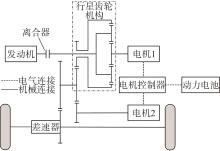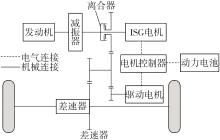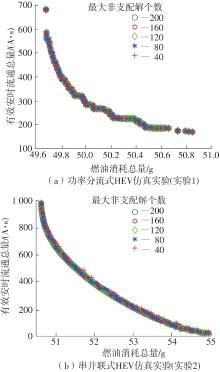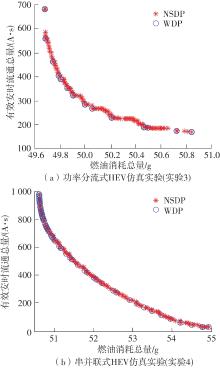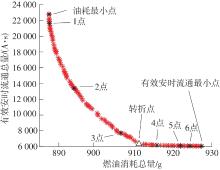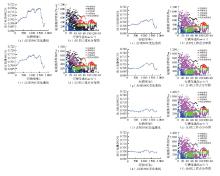| 1 |
王钦普,游思雄,李亮,等 .插电式混合动力汽车能量管理策略研究综述[J].机械工程学报,2017,53:1-19.
|
|
WANG Qinpu, YOU Sixiong, LI Liang,et al .Survey on energy management strategy for plug-in hybrid electric vehicles[J].Journal of Mechanical Engineering,2017,53:1-19.
|
| 2 |
曾育平,秦大同,苏岭,等 .插电式混合动力汽车动力系统的成本、油耗和排放多目标参数优化[J].汽车工程,2016,38:397-402,434.
|
|
ZENG Yuping, QIN Datong, SU Ling,et al .Cost,fuel consumption and emission multi-objective parameter optimization for the powertrain of a plug-in HEV[J].Automotive Engineering,2016,38:397-402,434.
|
| 3 |
WANG W D, GUO X H, YANG C,et al .A multi-objective optimization energy management strategy for power split HEV based on velocity prediction[J].Energy,2021,238(A):121714.
|
| 4 |
秦大同,章晓星,姚明尧 .计及能耗经济性和电池寿命的PHEV能量管理策略优化[J].重庆大学学报,2020,43:1-11.
|
|
QIN Datong, ZHANG Xiaoxing, YAO Mingyao .Optimization of PHEV energy management strategy considering battery life and energy cinsumption economy[J].Journal of Chongqing University,2020,43:1-11.
|
| 5 |
EBBESEN S, ELBERT P, GUZZELLA L .Battery state-of-health perceptive energy management for hybrid electric vehicles[J].IEEE Transactions on Vehicular Technology,2012,61:2893-2900.
|
| 6 |
邓涛,林椿松,李亚南,等 .采用NSGA-Ⅱ算法的混合动力能量管理控制多目标优化方法[J].西安交通大学学报,2015,49:143-150.
|
|
DENG Tao, LIN Chunsong, LI Yanan,et al .A multi-objective optimization method for energy management control of hybrid electric vehicles using NSGA-Ⅱ algorithm[J].Journal of Xi’an Jiaotong University,2015,49:143-150.
|
| 7 |
高建平,孙家辉,郗建国,等 .基于实际道路工况的混合动力客车能量管理策略多目标优化[J].汽车技术,2020(2):22-27.
|
|
GAO Jianping, SUN Jiahui, XI Jianguo,et al .Multi-objective optimization of energy management strategy for hybrid electric bus based on actual road conditions[J].Automobile Technology,2020(2):22-27.
|
| 8 |
邓涛,林椿松,李亚南,等 .基于Pareto原理的HEV能量控制参数NSGA-Ⅱ多目标优化的研究[J].汽车工程,2016,38:531-537.
|
|
DENG Tao, LIN Chunsong, LI Yanan,et al .A research on NSGA-II multi-objective optimization for HEV energy management parameters based on pareto principle[J].Automotive Engineering,2016,38:531-537.
|
| 9 |
CHENG R, RODEMANN T, FISCHER M,et al .Evolutionary many-objective optimization of hybrid electric vehicle control:from general optimization to preference articulation[J].IEEE Transactions on Emerging Topics in Computational Intelligence,2017,1:97-111.
|
| 10 |
耿文冉,楼狄明,张彤 .基于粒子群优化的混合动力汽车多目标能量管理策略[J].同济大学学报(自然科学版),2020,48:1030-1039.
|
|
GENG Wenran, LOU Diming, ZHANG Tong .Multi-objective energy management strategy for hybrid electric vehicle based on particle swarm optimization[J].Journal of Tongji University(Nature Science),2020,48:1030-1039.
|
| 11 |
ZHANG Y, LIU H P, GUO Q .Varying-domain optimal management strategy for parallel hybrid electric vehicles[J].IEEE Transactions on Vehicular Technology,2014,63:603-616.
|
| 12 |
闻育,吴铁军 .求解复杂多阶段决策问题的动态窗口蚁群优化算法[J].自动化学报.2004(6):872-879.
|
|
WEN Yu, WU Tiejun .Dynamically-window-search ant colony optimization for complex multi-stage decision making problems[J].ACTA Automatica Sinica,2004(6):872-879.
|
| 13 |
GANGULY S, SAHOO N C,DAS D .Multi-objective planning of electrical distribution systems using dynamic programming[J].International Journal of Electrical Power and Energy Systems,2013,46:65-78.
|
| 14 |
彭建刚,刘明州,张铭鑫,等 .多目标柔性作业车间调度算法研究综述[J].中国机械工程,2014,25:3244-3254.
|
|
PENG Jiangang, LIU Mingzhou, ZHANG Mingxin,et al .Review on scheduling algorithms for MOFJSP[J].China Mechanical Engineering,2014,25:3244-3254.
|
| 15 |
LI J Q, JIN X, XIONG R .Multi-objective optimization study of energy management strategy and economic analysis for a range-extended electric bus[J].Applied Energy,2017,194:798-807.
|
| 16 |
曾小华,王星琦,宋大凤,等 .考虑电池寿命的插电式混合动力汽车能量管理优化[J].浙江大学学报(工学版),2019,53:2206-2214.
|
|
ZENG Xiaohua, WANG Xingqi, SONG Dafeng,et al .Battery-health conscious energy management optimization in plug-in hybrid electric vehicles[J].Journal of Zhejiang University(Engineering Science),2019,53:2206-2214.
|
| 17 |
LI T, GIORGIO R .Energy management strategy including battery life optimization for a HEV with a CVT[C]// 2016 IEEE Transportation Electrification Conference and Expo,Asia-Pacific (ITEC Asia-Pacific).Busan,Korea,[s.n.],2016.
|
| 18 |
隗寒冰,秦大同,段志辉,等 .重度混合动力汽车燃油经济性和排放多目标优化[J].汽车工程,2011,33:937-941,936.
|
|
WEI Hanbing, QIN Datong, DUAN Zhihui,et al .Multi-objective optimization for the fuel economy and emissions of full hybrid electric vehicle[J].Automotive Engineering,2011,33:937-941,936.
|
| 19 |
贺莉,刘庆怀 .多目标优化理论与连续化方法[M].北京:科学出版社,2015.
|
| 20 |
LIANG X, CHEN J, GU X,et al .Improved adaptive non-dominated sorting genetic algorithm with elite strategy for solving multi-objective flexible job-shop scheduling problem[J].IEEE Access,2021,9:106352-106362.
|
| 21 |
SERRAO L, ONORI S, SCIARRETTA A,et al .Optimal energy management of hybrid electric vehicles including battery aging[C]∥Proceedings of the 2011 American Control Conference.[S.l.]:IEEE,2011:2125-2130.
|
| 22 |
LI X M, HAN L J, LIU H,et al .Real-time optimal energy management strategy for a dual-mode power-split hybrid electric vehicle based on an explicit model predictive control algorithm[J].Energy,2019,172:1161-1178.
|
| 23 |
张昊,范钦灏,王巍,等 .基于强化学习的多燃烧模式混合动力能量管理策略[J].汽车工程,2021,43:683-691.
|
|
ZHANG Hao, FAN Qinhao, WANG Wei,et al .Reinforcement learning based energy management strategy for hybrid electric vehicles using multi-mode combustion[J].Automotive Engineering,2021,43:683-691.
|
| 24 |
高建平,何洪文,孙逢春 .混合动力电动汽车机电耦合系统归类分析[J].北京理工大学学报,2008(3):197-201.
|
|
GAO Jianping, HE Hongwen, SUN Fengchun .Classification of electromechanical coupling systems in hybrid electric vehicles[J].Transactions of Beijing Institute of Technology,2008(3):197-201.
|
| 25 |
栗三一,王延峰,乔俊飞,等 .一种基于区域局部搜索的NSGA-Ⅱ算法[J].自动化学报,2020,46:2617-2627.
|
|
LI Sanyi, WANG Yanfeng, QIAO Junfeng,et al .A regional local search strategy for NSGA-II algorithm[J].ACTA Automatica Sinica,2020,46:2617-2627.
|
| 26 |
SAID R, BECHIKH S, LOUATI A,et al .Solving combinatorial multi-objective Bi-level optimization problems using multiple populations and migration schemes[J].IEEE Access,2020,8:141674-141695.
|
| 27 |
崔志华,张茂清,常宇,等 .基于平均距离聚类的NSGA-Ⅱ[J].自动化学报,2021,47(5):1171-1182.
|
|
CUI Zhihua, ZHANG Maoqing, CHANG Yu,et al .NSGA-II with average distance clustering[J].ACTA Automatica Sinica,2021,47(5):1171-1182.
|
| 28 |
LIU W, LUO F M, LIU Y H,et al .Optimal siting and szing of distributed generation based on improved nondominated sorting genetic algorithm II[J].Processes,2019,7(12):955.
|
| 29 |
XU X F, HAO J, ZHENG Y .Multi-objective artificial bee colony algorithm for multi-stage resource leveling problem in sharing logistics network[J].Computers & Industrial Engineering,2020,142:106338.
|
